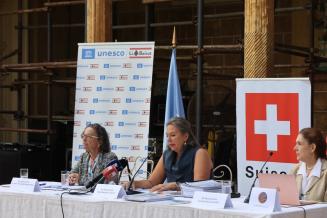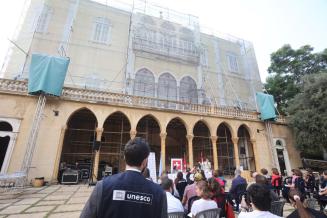Through the LiBeirut initiative, UNESCO places heritage at the heart of the international efforts of recovery. The Sursock Palace is a gem of Lebanese architecture and a powerful symbol of pride and resilience for the Beirut community. I would like to thank the Swiss Confederation and the Sursock Palace Association for their major support for this rehabilitationAudrey Azoulay UNESCO Director-General


Progressive reopening to the public
The funding enables UNESCO to restore the lost structural continuity of the building, starting with the most affected areas: the northern elevation and of the two northern pitched roofs. UNESCO will apply internationally recognized professional standards in all the rehabilitation and restoration work. The Sursock Palace Association will progressively open the palace to the public as a private museum, and a cultural hub, providing a space for the cultural and creative industries to exhibit their work and engage with the community.
UNESCO has prioritized the rehabilitation of the Palace because of its architectural and urban importance, and its significant role in Beirut's history. We hope that the funding offered by the Swiss Confederation will trigger additional support to complete further phases in the Palace's restoration. We also hope that further investments will be made in cultural heritage, which is at the very heart of UNESCO mandateCostanza Farina Director of the UNESCO Regional Bureau in Beirut
This rehabilitation is made possible by the important work carried out by UNESCO and ICONEM, a startup that specialises in the digitisation of endangered cultural heritage sites in 3D, to document the zones damaged by the port blasts in 3D, including the Sursock Palace and two other heritage buildings.
Exemplary collaboration
Marion Weichelt, the Swiss Ambassador to Lebanon, highlighted that "heritage is a pillar of a country's culture, and constitutes one of the strongest foundations for social cohesion. The rehabilitation of the Palace is a milestone for the long-term project of opening the Palace to the public and engaging with the community. This is to the benefit of all and especially to the heritage and cultural scene of Beirut. Switzerland has been standing next to Lebanon in many ways by supporting the rebuilding of key sectors such as health, education and evidently, as today, culture. We hope that our contribution to the rehabilitation of the Palace will be one of the many supportive steps towards the revival of the heart and soul of the city of Beirut."
The Sursock Palace Association is pleased to collaborate on the first stage of restoration of the North façade and two North roofs of the Palace with UNESCO. This has been made possible with the generosity of the Swiss Federal Office of Culture, which will also be met by additional financing from the Sursock Palace Association resources.Mary Cochrane Board member of the Sursock Palace association
A Witness to History
The palace is one of the country's largest residences of the Ottoman era. A century after its construction, it was listed by the Lebanese Ministry of Culture as a building of historical importance. It suffered profound damage during the Lebanese civil war of 1975-1990, and underwent a 20-year restoration process. In 2010, it was re-opened to the public, but was then badly damaged again in the 4 August 2020 port blasts.
The North elevation of the Palace bore the brunt of the explosion, suffering huge out-of-plane deformation. The red tiled roofs were profoundly punctured, and every single window and door was shattered, leaving the entire edifice exposed to the elements. Photos of the damage quickly surfaced on social networks and media outlets, proving the Palace's symbolic value to the Beiruti community.
The announcement was made during a press conference held by UNESCO and the Swiss embassy in Lebanon, at the Sursock Palace.
LiBeirut is an international flagship initiative launched from Beirut by the Director-General of UNESCO, Audrey Azoulay, in the aftermath of the explosions, on August 27, 2020 to support the rehabilitation of schools, historic heritage buildings, museums, galleries and the creative industries, all heavily impacted by the deadly explosions. Through this initiative, UNESCO has also completed the rehabilitation of 280 educational institutions.






